A High-Resolution LED Stimulator for Steady-State Visual Stimulation: Customizable, Affordable, and Open Source
Abstract
1. Introduction
2. Materials and Methods
2.1. LED Stimulator
| Listing 1. Code snippet to generate the LED control signal. |
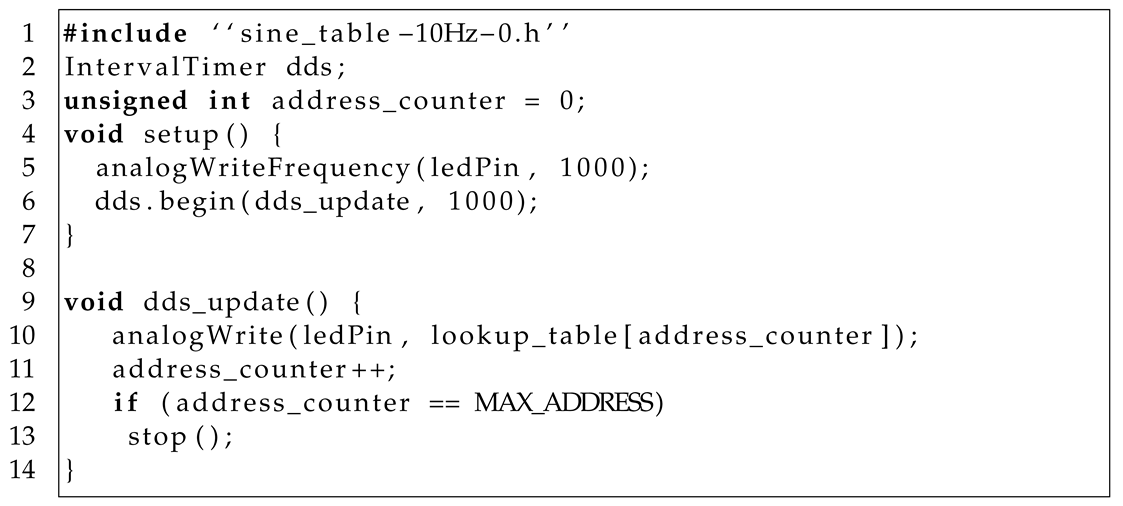 |
2.2. Experimental Design
2.2.1. Experiments 1 and 2
2.2.2. Experiments 3 and 4
3. Results
3.1. Experiments 1 and 2
3.2. Experiments 3 and 4
4. Discussion
4.1. Comparison with Other Available Systems
4.2. Applications in Advance Research in Visual Processing within the Context of Health and Disease
4.3. Applications within and beyond Visual Stimulation
5. Conclusions
Author Contributions
Funding
Institutional Review Board Statement
Informed Consent Statement
Data Availability Statement
Conflicts of Interest
Abbreviations
| LED | Light-emitting diode |
| EEG | Electroencephalogram |
| SSVEP | Steady-state visually evoked potential |
| PWM | Pulse width modulation |
| DDS | Direct digital synthesis |
| PSD | Power spectral density |
| IDE | Integrated development environment |
| IAF | Individual alpha frequency |
| AD | Alzheimer’s disease |
| FFT | Fast Fourier transform |
| SNR | Signal-to-noise ratio |
| RNL | Residual noise level |
| F0 | Fundamental frequency |
References
- Norcia, A.M.; Appelbaum, L.G.; Ales, J.M.; Cottereau, B.R.; Rossion, B. The steady-state visual evoked potential in vision research: A review. J. Vis. 2015, 15, 4. [Google Scholar] [CrossRef] [PubMed]
- Kritzman, L.; Eidelman-Rothman, M.; Keil, A.; Freche, D.; Sheppes, G.; Levit-Binnun, N. Steady-state visual evoked potentials differentiate between internally and externally directed attention. NeuroImage 2022, 254, 119133. [Google Scholar] [CrossRef] [PubMed]
- Yang, H.; Paller, K.A.; van Vugt, M. The steady state visual evoked potential (SSVEP) tracks “sticky” thinking, but not more general mind-wandering. Front. Hum. Neurosci. 2022, 16, 892863. [Google Scholar] [CrossRef] [PubMed]
- Zhang, S.; Gao, X. The effect of visual stimuli noise and fatigue on steady-state visual evoked potentials. J. Neural Eng. 2019, 16, 056023. [Google Scholar] [CrossRef] [PubMed]
- Schielke, A.; Krekelberg, B. Steady state visual evoked potentials in schizophrenia: A review. Front. Neurosci. 2022, 16, 988077. [Google Scholar] [CrossRef] [PubMed]
- Tabanfar, Z.; Firoozabadi, M.; Shankayi, Z.; Sharifi, G. Screening of Brain Tumors Using Functional Connectivity Patterns of Steady-State Visually Evoked Potentials. Brain Connect. 2022, 12, 883–891. [Google Scholar] [CrossRef]
- Danjou, P.; Viardot, G.; Maurice, D.; Garcés, P.; Wams, E.; Phillips, K.; Bertaina-Anglade, V.; McCarthy, A.; Pemberton, D. Electrophysiological assessment methodology of sensory processing dysfunction in schizophrenia and dementia of the Alzheimer type. Neurosci. Biobehav. Rev. 2019, 97, 70–84. [Google Scholar] [CrossRef] [PubMed]
- Murty, D.V.; Manikandan, K.; Kumar, W.S.; Ramesh, R.G.; Purokayastha, S.; Nagendra, B.; Ml, A.; Balakrishnan, A.; Javali, M.; Rao, N.P.; et al. Stimulus-induced gamma rhythms are weaker in human elderly with mild cognitive impairment and Alzheimer’s disease. Elife 2021, 10, e61666. [Google Scholar] [CrossRef]
- Lalancette, E.; Charlebois-Poirier, A.R.; Agbogba, K.; Knoth, I.S.; Jones, E.J.; Mason, L.; Perreault, S.; Lippé, S. Steady-state visual evoked potentials in children with neurofibromatosis type 1: Associations with behavioral rating scales and impact of psychostimulant medication. J. Neurodev. Disord. 2022, 14, 42. [Google Scholar] [CrossRef]
- Richard, N.; Nikolic, M.; Mortensen, E.L.; Osler, M.; Lauritzen, M.; Benedek, K. Steady-state visual evoked potential temporal dynamics reveal correlates of cognitive decline. Clin. Neurophysiol. 2020, 131, 836–846. [Google Scholar] [CrossRef]
- Nakanishi, M.; Wang, Y.; Wang, Y.T.; Mitsukura, Y.; Jung, T.P. Generating visual flickers for eliciting robust steady-state visual evoked potentials at flexible frequencies using monitor refresh rate. PLoS ONE 2014, 9, e99235. [Google Scholar] [CrossRef] [PubMed]
- Vialatte, F.B.; Maurice, M.; Dauwels, J.; Cichocki, A. Steady-state visually evoked potentials: Focus on essential paradigms and future perspectives. Prog. Neurobiol. 2010, 90, 418–438. [Google Scholar] [CrossRef] [PubMed]
- Herrmann, C.S. Human EEG responses to 1–100 Hz flicker: Resonance phenomena in visual cortex and their potential correlation to cognitive phenomena. Exp. Brain Res. 2001, 137, 346–353. [Google Scholar] [CrossRef] [PubMed]
- Chang, M.H.; Baek, H.J.; Lee, S.M.; Park, K.S. An amplitude-modulated visual stimulation for reducing eye fatigue in SSVEP-based brain–computer interfaces. Clin. Neurophysiol. 2014, 125, 1380–1391. [Google Scholar] [CrossRef] [PubMed]
- Dreyer, A.M.; Herrmann, C.S. Frequency-modulated steady-state visual evoked potentials: A new stimulation method for brain–computer interfaces. J. Neurosci. Methods 2015, 241, 1–9. [Google Scholar] [CrossRef] [PubMed]
- Kimura, Y.; Tanaka, T.; Higashi, H.; Morikawa, N. SSVEP-Based Brain–Computer Interfaces Using FSK-Modulated Visual Stimuli. IEEE Trans. Biomed. Eng. 2013, 60, 2831–2838. [Google Scholar] [CrossRef]
- Ge, S.; Jiang, Y.; Zhang, M.; Wang, R.; Iramina, K.; Lin, P.; Leng, Y.; Wang, H.; Zheng, W. SSVEP-Based Brain-Computer Interface With a Limited Number of Frequencies Based on Dual-Frequency Biased Coding. IEEE Trans. Neural Syst. Rehabil. Eng. 2021, 29, 760–769. [Google Scholar] [CrossRef]
- Klimesch, W.; Sauseng, P.; Hanslmayr, S. EEG alpha oscillations: The inhibition–timing hypothesis. Brain Res. Rev. 2007, 53, 63–88. [Google Scholar] [CrossRef]
- Mathewson, K.E.; Lleras, A.; Beck, D.M.; Fabiani, M.; Ro, T.; Gratton, G. Pulsed out of awareness: EEG alpha oscillations represent a pulsed-inhibition of ongoing cortical processing. Front. Psychol. 2011, 2, 99. [Google Scholar] [CrossRef]
- Ronconi, L.; Melcher, D. The role of oscillatory phase in determining the temporal organization of perception: Evidence from sensory entrainment. J. Neurosci. 2017, 37, 10636–10644. [Google Scholar] [CrossRef]
- Otero, M.; Prado-Gutiérrez, P.; Weinstein, A.; Escobar, M.J.; El-Deredy, W. Persistence of eeg alpha entrainment depends on stimulus phase at offset. Front. Hum. Neurosci. 2020, 14, 139. [Google Scholar] [CrossRef]
- Fiene, M.; Schwab, B.C.; Misselhorn, J.; Herrmann, C.S.; Schneider, T.R.; Engel, A.K. Phase-specific manipulation of rhythmic brain activity by transcranial alternating current stimulation. Brain Stimul. 2020, 13, 1254–1262. [Google Scholar] [CrossRef] [PubMed]
- Mohan, N.; Undeland, T.M.; Robbins, W.P. Power Electronics: Converters, Applications, and Design; John Wiley & Sons: New York, NY, USA, 2003. [Google Scholar]
- Cordesses, L. Direct digital synthesis: A tool for periodic wave generation (part 1). IEEE Signal Process. Mag. 2004, 21, 50–54. [Google Scholar] [CrossRef]
- Available online: https://octopart.com/ (accessed on 1 December 2023).
- Hwang, H.J.; Lim, J.H.; Jung, Y.J.; Choi, H.; Lee, S.W.; Im, C.H. Development of an SSVEP-based BCI spelling system adopting a QWERTY-style LED keyboard. J. Neurosci. Methods 2012, 208, 59–65. [Google Scholar] [CrossRef] [PubMed]
- Dreyer, A.M.; Herrmann, C.S.; Rieger, J.W. Tradeoff between user experience and BCI classification accuracy with frequency modulated steady-state visual evoked potentials. Front. Hum. Neurosci. 2017, 11, 391. [Google Scholar] [CrossRef] [PubMed]
- Mouli, S.; Palaniappan, R. DIY hybrid SSVEP-P300 LED stimuli for BCI platform using EMOTIV EEG headset. HardwareX 2020, 8, e00113. [Google Scholar] [CrossRef] [PubMed]
- Plöchl, M.; Fiebelkorn, I.; Kastner, S.; Obleser, J. Attentional sampling of visual and auditory objects is captured by theta-modulated neural activity. Eur. J. Neurosci. 2022, 55, 3067–3082. [Google Scholar] [CrossRef]
- Lambert, T.R. An Introduction to Microcontrollers and Embedded Systems. 2017. Available online: https://www.researchgate.net/profile/Tyler-Lambert/publication/340062601_Introduction_to_Microcontrollers_and_Embedded_Systems/links/5e7a4332299bf1f3873f8a24/Introduction-to-Microcontrollers-and-Embedded-Systems.pdf (accessed on 1 December 2023).
- Graeme, J. Photodiode Amplifiers: Op Amp Solutions; McGraw-Hill, Inc.: New York, NY, USA, 1995. [Google Scholar]
- Stoica, P.; Moses, R.L. Spectral Analysis of Signals; Pearson Prentice Hall: Upper Saddle River, NJ, USA, 2005; Volume 452. [Google Scholar]
- Orfanidis, S.J. Introduction to Signal Processing; Prentice-Hall, Inc.: Upper Saddle River, NJ, USA, 1995. [Google Scholar]
- Prado-Gutiérrez, P.; Otero, M.; Martínez-Montes, E.; Weinstein, A.; Escobar, M.J.; El-Deredy, W.; Zañartu, M. A method for tracking the time evolution of steady-state evoked potentials. J. Vis. Exp. 2019, 147, e59898. [Google Scholar]
- Tarasi, L.; Romei, V. Individual alpha frequency contributes to the precision of human visual processing. J. Cogn. Neurosci. 2023, 1–11. [Google Scholar] [CrossRef]
- Klimesch, W.; Sauseng, P.; Gerloff, C. Enhancing cognitive performance with repetitive transcranial magnetic stimulation at human individual alpha frequency. Eur. J. Neurosci. 2003, 17, 1129–1133. [Google Scholar] [CrossRef]
- Manolakis, D.G.; Ingle, V.K. Applied Digital Signal Processing: Theory and Practice; Cambridge University Press: Cambridge, UK, 2011. [Google Scholar]
- Prado-Gutierrez, P.; Castro-Fariñas, A.; Morgado-Rodriguez, L.; Velarde-Reyes, E.; Martínez, A.D.; Martínez-Montes, E. Habituation of auditory steady state responses evoked by amplitude-modulated acoustic signals in rats. Audiol. Res. 2015, 5, 113. [Google Scholar] [CrossRef] [PubMed]
- Prado-Gutierrez, P.; Martínez-Montes, E.; Weinstein, A.; Zañartu, M. Estimation of auditory steady-state responses based on the averaging of independent EEG epochs. PLoS ONE 2019, 14, e0206018. [Google Scholar] [CrossRef] [PubMed]
- Valdes, J.L.; Perez-Abalo, M.C.; Martin, V.; Savio, G.; Sierra, C.; Rodriguez, E.; Lins, O. Comparison of statistical indicators for the automatic detection of 80 Hz auditory steady state responses. Ear Hear. 1997, 18, 420–429. [Google Scholar] [CrossRef] [PubMed][Green Version]
- Savio, G.; Cardenas, J.; Pérez Abalo, M.; Gonzalez, A.; Valdes, J. The low and high frequency auditory steady state responses mature at different rates. Audiol. Neurotol. 2001, 6, 279–287. [Google Scholar] [CrossRef]
- Oellermann, M.; Jolles, J.W.; Ortiz, D.; Seabra, R.; Wenzel, T.; Wilson, H.; Tanner, R.L. Open hardware in science: The benefits of open electronics. Integr. Comp. Biol. 2022, 62, 1061–1075. [Google Scholar] [CrossRef] [PubMed]
- Zlatanov, N. Arduino and open source computer hardware and software. J. Water Sanit. Hyg. Dev 2016, 10, 1–8. [Google Scholar]
- Sebar, L.E.; Angelini, E.; Grassini, S.; Iannucci, L.; Parvis, M. An op amp-less Electrochemical Impedance Spectroscopy System. In Proceedings of the 2020 IEEE International Instrumentation and Measurement Technology Conference (I2MTC), Dubrovnik, Croatia, 25–29 May 2020; pp. 1–6. [Google Scholar] [CrossRef]
- Sebar, L.E.; Iannucci, L.; Angelini, E.; Grassini, S.; Parvis, M. Electrochemical impedance spectroscopy system based on a teensy board. IEEE Trans. Instrum. Meas. 2020, 70, 6001809. [Google Scholar] [CrossRef]
- Guidorzi, P.; Garai, M. A Low-Cost System for Quick Measurements on Noise Barriers in Situ. IEEE Trans. Instrum. Meas. 2022, 71, 6503714. [Google Scholar] [CrossRef]
- Lombardo, L. Multi-platform solution for data acquisition. Acta IMEKO 2023, 12, 1. [Google Scholar] [CrossRef]
- Reiser, M.B.; Dickinson, M.H. A modular display system for insect behavioral neuroscience. J. Neurosci. Methods 2008, 167, 127–139. [Google Scholar] [CrossRef]
- Teikari, P.; Najjar, R.P.; Malkki, H.; Knoblauch, K.; Dumortier, D.; Gronfier, C.; Cooper, H.M. An inexpensive Arduino-based LED stimulator system for vision research. J. Neurosci. Methods 2012, 211, 227–236. [Google Scholar] [CrossRef] [PubMed]
- da Silva Pinto, M.A.; de Souza, J.K.S.; Baron, J.; Tierra-Criollo, C.J. A low-cost, portable, micro-controlled device for multi-channel LED visual stimulation. J. Neurosci. Methods 2011, 197, 82–91. [Google Scholar] [CrossRef] [PubMed]
- Lea-Carnall, C.A.; Montemurro, M.A.; Trujillo-Barreto, N.J.; Parkes, L.M.; El-Deredy, W. Cortical resonance frequencies emerge from network size and connectivity. PLoS Comput. Biol. 2016, 12, e1004740. [Google Scholar] [CrossRef] [PubMed]
- Collura, T.F.; David Siever, C. Auditory-Vsual Entrainment in Relation to Mental Health and EEG; Academic: New York, NY, USA, 2009; pp. 195–225. [Google Scholar]
- Sabel, B.A.; Thut, G.; Haueisen, J.; Henrich-Noack, P.; Herrmann, C.S.; Hunold, A.; Kammer, T.; Matteo, B.; Sergeeva, E.G.; Waleszczyk, W.; et al. Vision modulation, plasticity and restoration using non-invasive brain stimulation–An IFCN-sponsored review. Clin. Neurophysiol. 2020, 131, 887–911. [Google Scholar] [CrossRef] [PubMed]
- Lopez-Diaz, K.; Henshaw, J.; Casson, A.J.; Brown, C.A.; Taylor, J.R.; Trujillo-Barreto, N.J.; Arendsen, L.J.; Jones, A.K.; Sivan, M. Alpha entrainment drives pain relief using visual stimulation in a sample of chronic pain patients: A proof-of-concept controlled study. Neuroreport 2021, 32, 394–398. [Google Scholar] [CrossRef] [PubMed]
- Arendsen, L.J.; Henshaw, J.; Brown, C.A.; Sivan, M.; Taylor, J.R.; Trujillo-Barreto, N.J.; Casson, A.J.; Jones, A.K. Entraining alpha activity using visual stimulation in patients with chronic musculoskeletal pain: A feasibility study. Front. Neurosci. 2020, 14, 828. [Google Scholar] [CrossRef]
- Ecsy, K.; Brown, C.; Jones, A. Cortical nociceptive processes are reduced by visual alpha-band entrainment in the human brain. Eur. J. Pain 2018, 22, 538–550. [Google Scholar] [CrossRef]
- Köster, M.; Martens, U.; Gruber, T. Memory entrainment by visually evoked theta-gamma coupling. NeuroImage 2019, 188, 181–187. [Google Scholar] [CrossRef]
- Mazaheri, A.; Seminowicz, D.A.; Furman, A.J. Peak alpha frequency as a candidate biomarker of pain sensitivity: The importance of distinguishing slow from slowing. NeuroImage 2022, 262, 119560. [Google Scholar] [CrossRef]
- Furman, A.J.; Thapa, T.; Summers, S.J.; Cavaleri, R.; Fogarty, J.S.; Steiner, G.Z.; Schabrun, S.M.; Seminowicz, D.A. Cerebral peak alpha frequency reflects average pain severity in a human model of sustained, musculoskeletal pain. J. Neurophysiol. 2019, 122, 1784–1793. [Google Scholar] [CrossRef]
- Gulbinaite, R.; Van Viegen, T.; Wieling, M.; Cohen, M.X.; VanRullen, R. Individual alpha peak frequency predicts 10 Hz flicker effects on selective attention. J. Neurosci. 2017, 37, 10173–10184. [Google Scholar] [CrossRef]
- Ramsay, I.S.; Lynn, P.A.; Schermitzler, B.; Sponheim, S.R. Individual alpha peak frequency is slower in schizophrenia and related to deficits in visual perception and cognition. Sci. Rep. 2021, 11, 17852. [Google Scholar] [CrossRef] [PubMed]
- Yeum, T.S.; Kang, U.G. Reduction in alpha peak frequency and coherence on quantitative electroencephalography in patients with schizophrenia. J. Korean Med. Sci. 2018, 33, e179. [Google Scholar] [CrossRef] [PubMed]
- Arjmandi-Rad, S.; Vestergaard Nieland, J.D.; Goozee, K.G.; Vaseghi, S. The effects of different acetylcholinesterase inhibitors on EEG patterns in patients with Alzheimer’s disease: A systematic review. Neurol. Sci. 2023, 45, 417–430. [Google Scholar] [CrossRef]
- Vecchio, F.; Babiloni, C.; Lizio, R.; Fallani, F.D.V.; Blinowska, K.; Verrienti, G.; Frisoni, G.; Rossini, P.M. Resting state cortical EEG rhythms in Alzheimer’s disease: Toward EEG markers for clinical applications: A review. Suppl. Clin. Neurophysiol. 2013, 62, 223–236. [Google Scholar]
- Moretti, D.V.; Babiloni, C.; Binetti, G.; Cassetta, E.; Dal Forno, G.; Ferreric, F.; Ferri, R.; Lanuzza, B.; Miniussi, C.; Nobili, F.; et al. Individual analysis of EEG frequency and band power in mild Alzheimer’s disease. Clin. Neurophysiol. 2004, 115, 299–308. [Google Scholar] [CrossRef] [PubMed]
- Springer, S.D.; Wiesman, A.I.; May, P.E.; Schantell, M.; Johnson, H.J.; Willett, M.P.; Castelblanco, C.A.; Eastman, J.A.; Christopher-Hayes, N.J.; Wolfson, S.L.; et al. Altered visual entrainment in patients with Alzheimer’s disease: Magnetoencephalography evidence. Brain Commun. 2022, 4, fcac198. [Google Scholar] [CrossRef]
- Available online: https://dancerdesign.co.uk/tactor.html (accessed on 27 November 2023).
- Pokorny, C.; Breitwieser, C.; Müller-Putz, G.R. A tactile stimulation device for EEG measurements in clinical use. IEEE Trans. Biomed. Circuits Syst. 2013, 8, 305–312. [Google Scholar] [CrossRef]
- Giabbiconi, C.M.; Dancer, C.; Zopf, R.; Gruber, T.; Müller, M.M. Selective spatial attention to left or right hand flutter sensation modulates the steady-state somatosensory evoked potential. Cogn. Brain Res. 2004, 20, 58–66. [Google Scholar] [CrossRef]
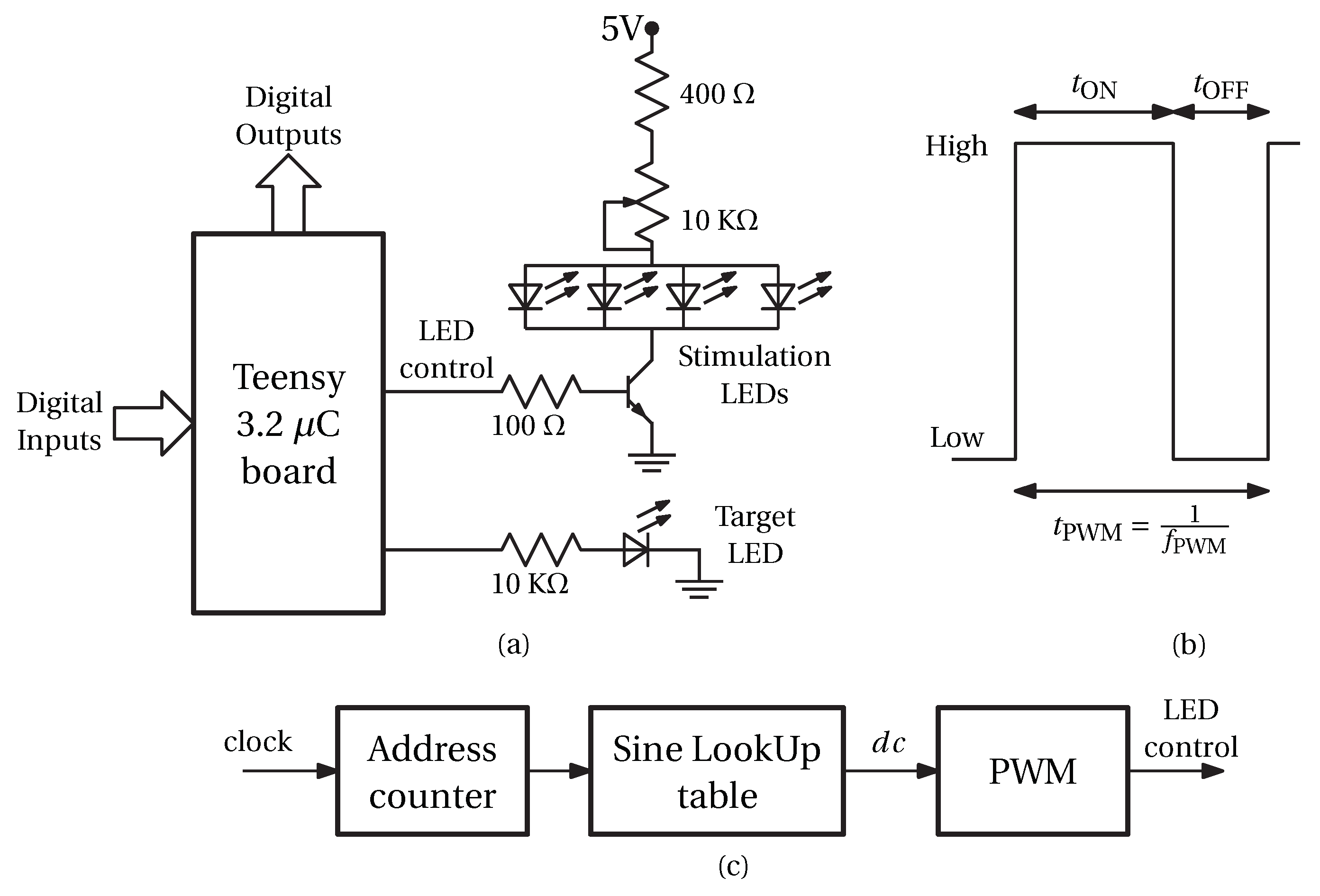

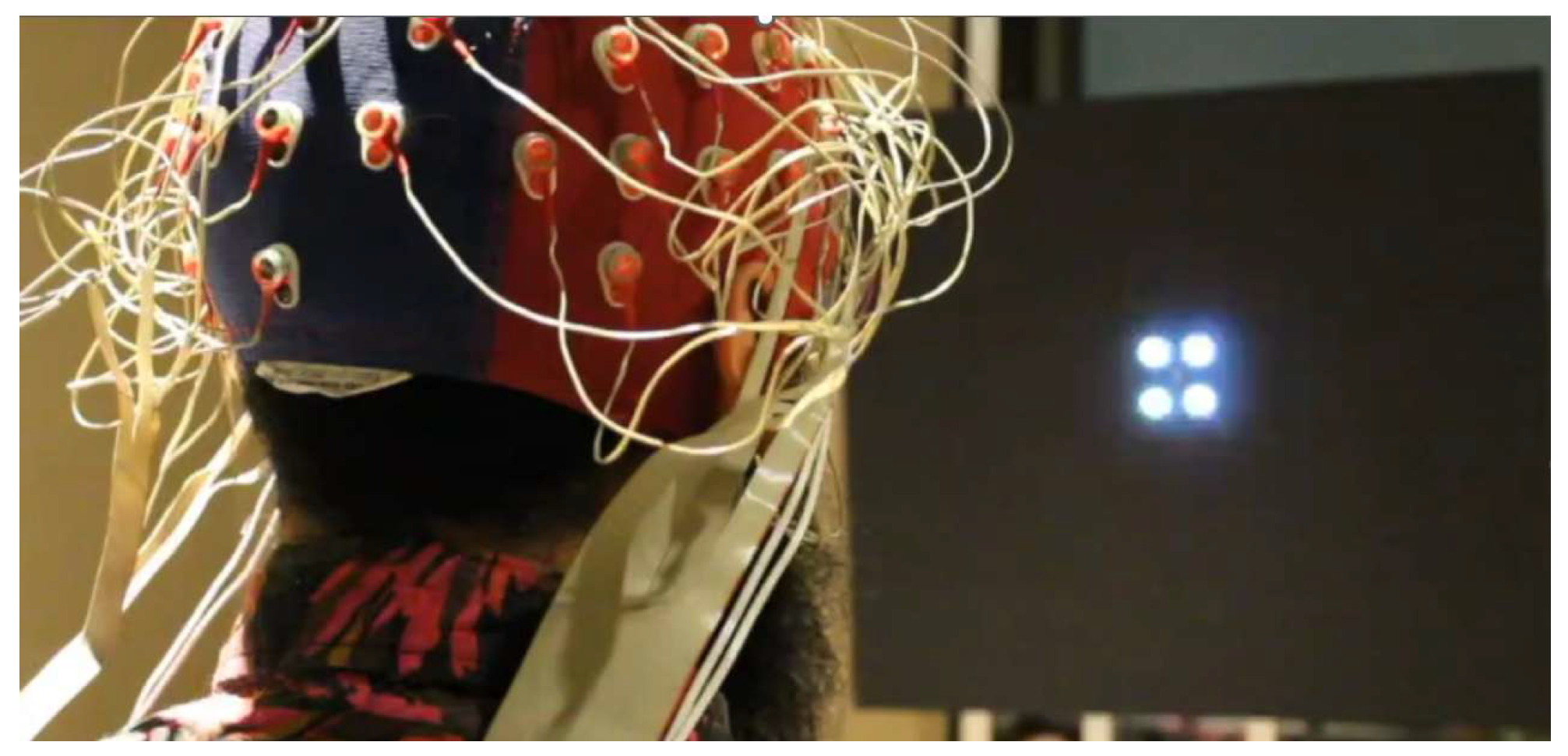
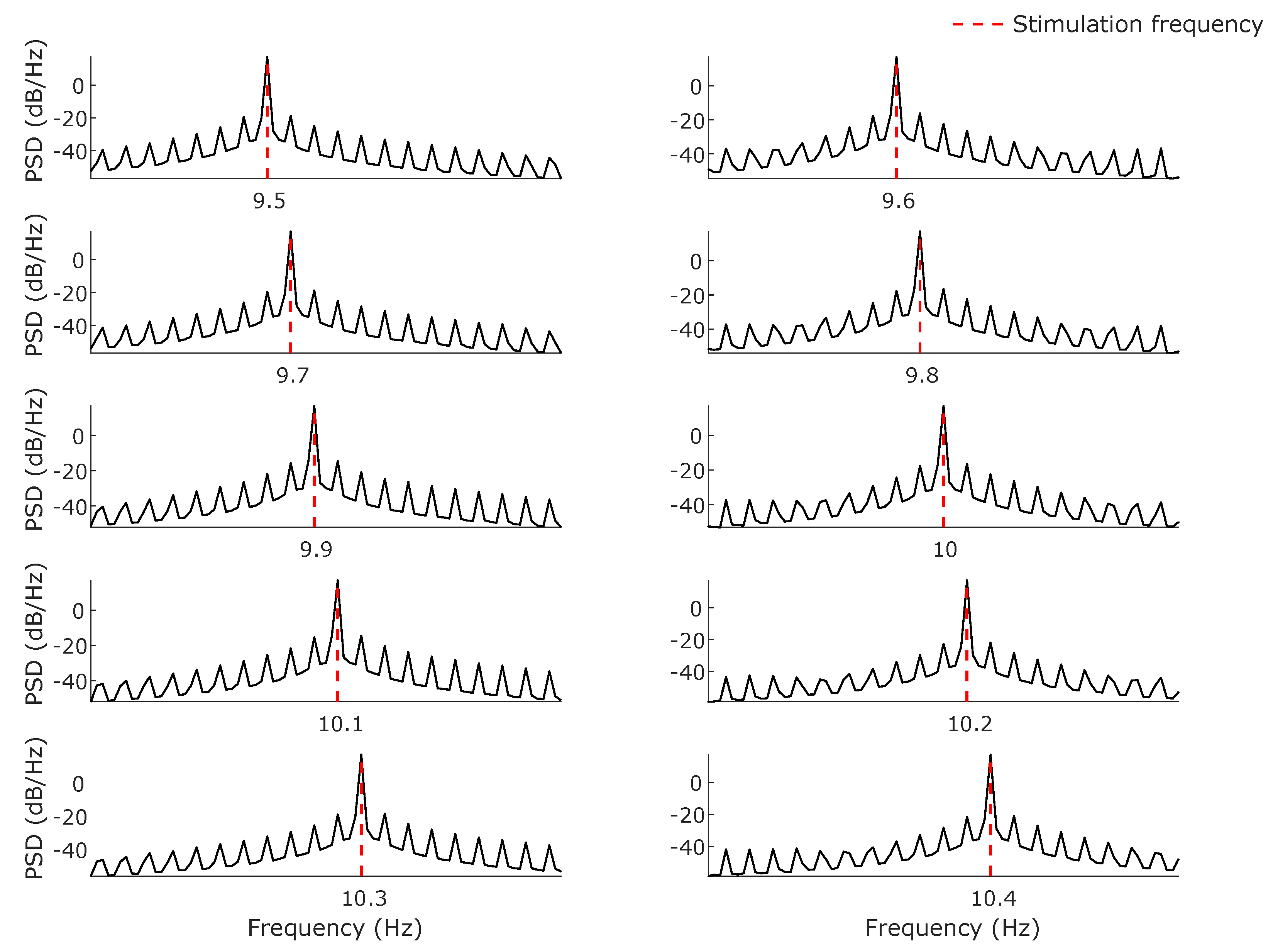
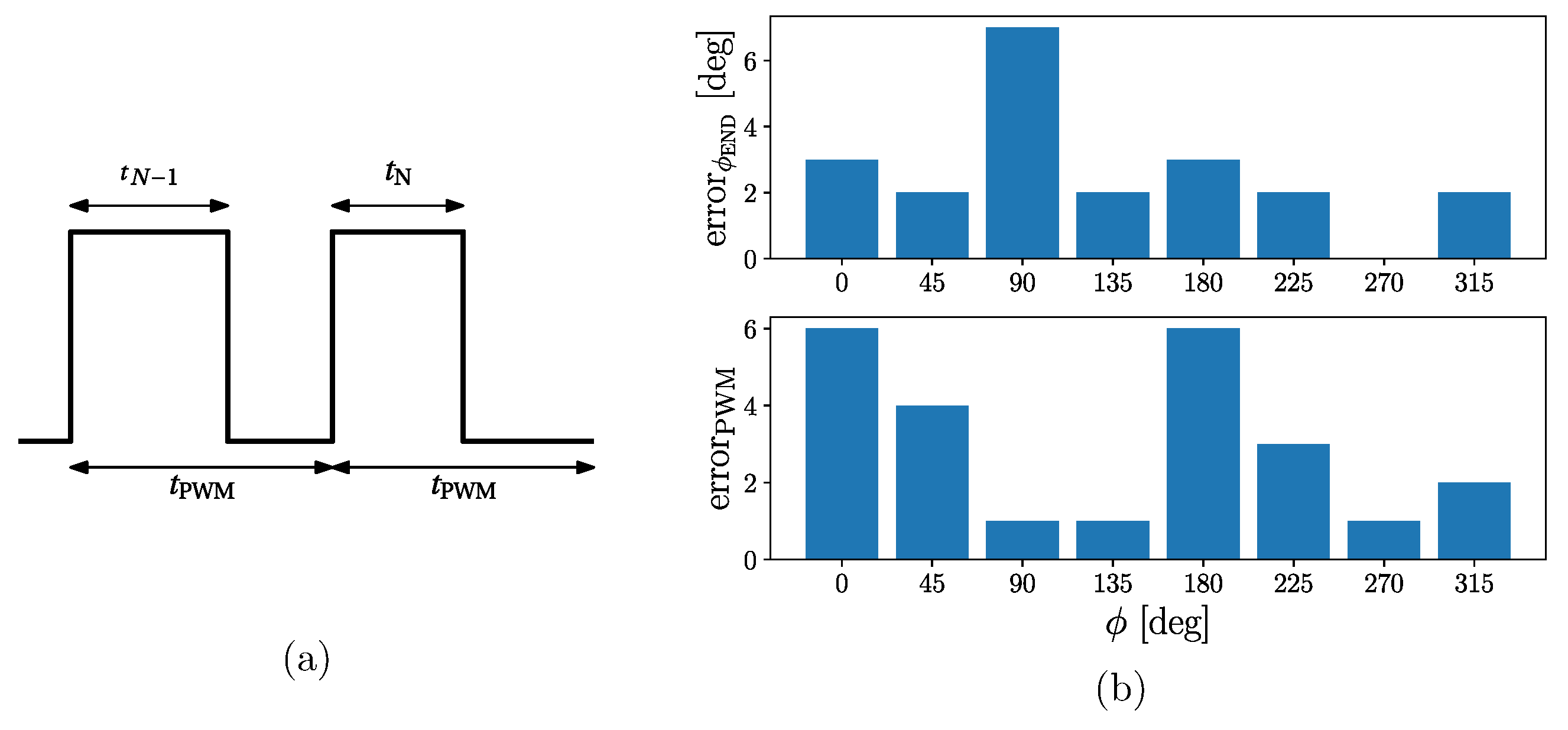
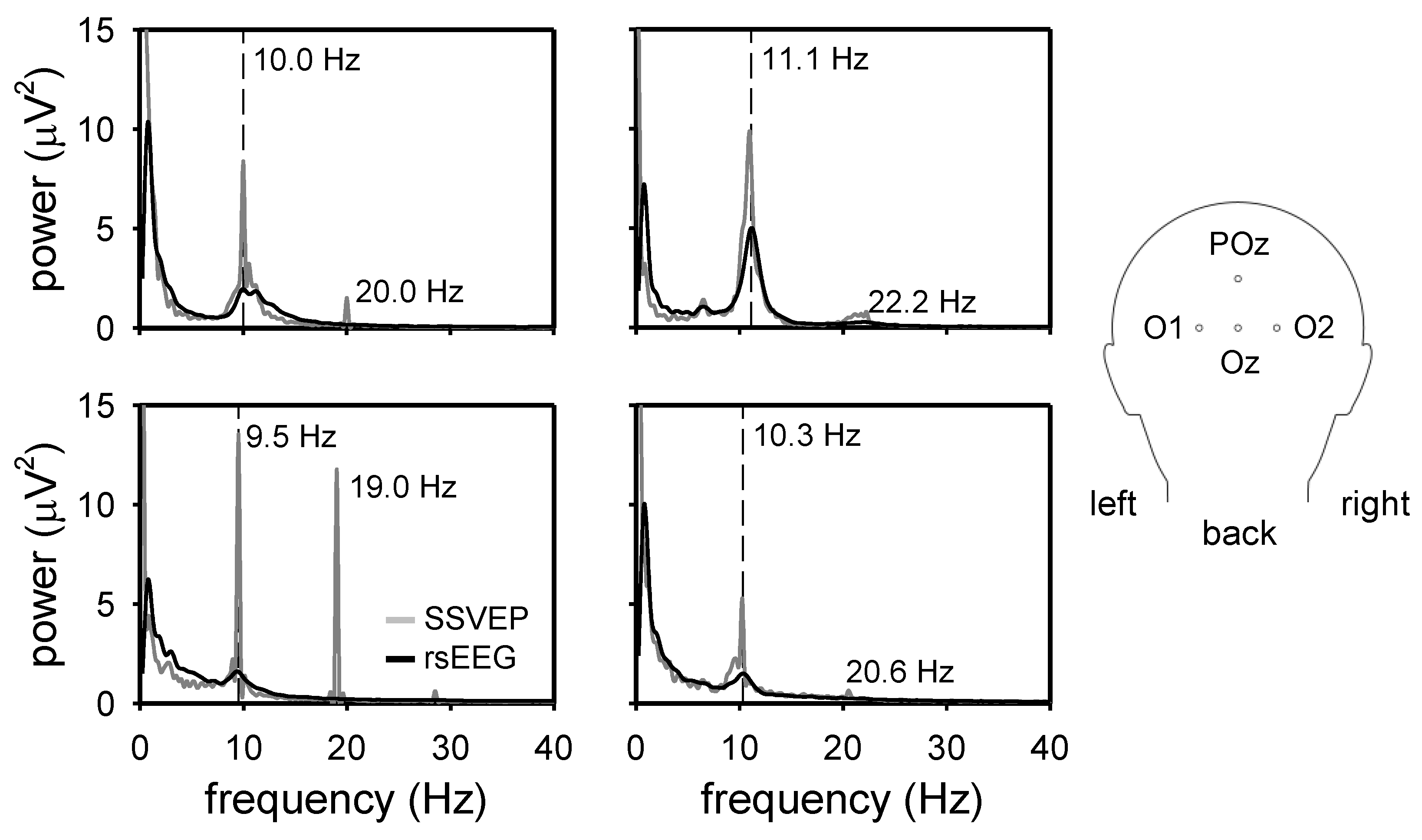
| Part | Quantity | Total Cost USD$ |
|---|---|---|
| Tensy 3.2 board | 1 | 23.2 |
| Power Supply | 1 | 9.0 |
| Resistors | 3 | 0.3 |
| Potentiometer | 3 | 3.8 |
| LED | 5 | 8.0 |
| Transistor | 1 | 0.3 |
| Assorted components | 1 | 20.0 |
| Total: | 64.3 |
| [deg] | [deg] | [deg] | PWMEND | ||
|---|---|---|---|---|---|
| 0° | 357° | 3° | 110 | 104 | 6 |
| 45° | 43° | 2° | 181 | 177 | 4 |
| 90° | 83° | 7° | 210 | 209 | 1 |
| 135° | 133° | 2° | 181 | 182 | 1 |
| 180° | 177° | 3° | 110 | 116 | 6 |
| 225° | 223° | 2° | 39 | 42 | 3 |
| 270° | 270° | 0° | 10 | 9 | 1 |
| 315° | 313° | 2° | 39 | 37 | 2 |
Disclaimer/Publisher’s Note: The statements, opinions and data contained in all publications are solely those of the individual author(s) and contributor(s) and not of MDPI and/or the editor(s). MDPI and/or the editor(s) disclaim responsibility for any injury to people or property resulting from any ideas, methods, instructions or products referred to in the content. |
© 2024 by the authors. Licensee MDPI, Basel, Switzerland. This article is an open access article distributed under the terms and conditions of the Creative Commons Attribution (CC BY) license (https://creativecommons.org/licenses/by/4.0/).
Share and Cite
Otero, M.; Prieur-Coloma, Y.; El-Deredy, W.; Weinstein, A. A High-Resolution LED Stimulator for Steady-State Visual Stimulation: Customizable, Affordable, and Open Source. Sensors 2024, 24, 678. https://doi.org/10.3390/s24020678
Otero M, Prieur-Coloma Y, El-Deredy W, Weinstein A. A High-Resolution LED Stimulator for Steady-State Visual Stimulation: Customizable, Affordable, and Open Source. Sensors. 2024; 24(2):678. https://doi.org/10.3390/s24020678
Chicago/Turabian StyleOtero, Mónica, Yunier Prieur-Coloma, Wael El-Deredy, and Alejandro Weinstein. 2024. "A High-Resolution LED Stimulator for Steady-State Visual Stimulation: Customizable, Affordable, and Open Source" Sensors 24, no. 2: 678. https://doi.org/10.3390/s24020678
APA StyleOtero, M., Prieur-Coloma, Y., El-Deredy, W., & Weinstein, A. (2024). A High-Resolution LED Stimulator for Steady-State Visual Stimulation: Customizable, Affordable, and Open Source. Sensors, 24(2), 678. https://doi.org/10.3390/s24020678









